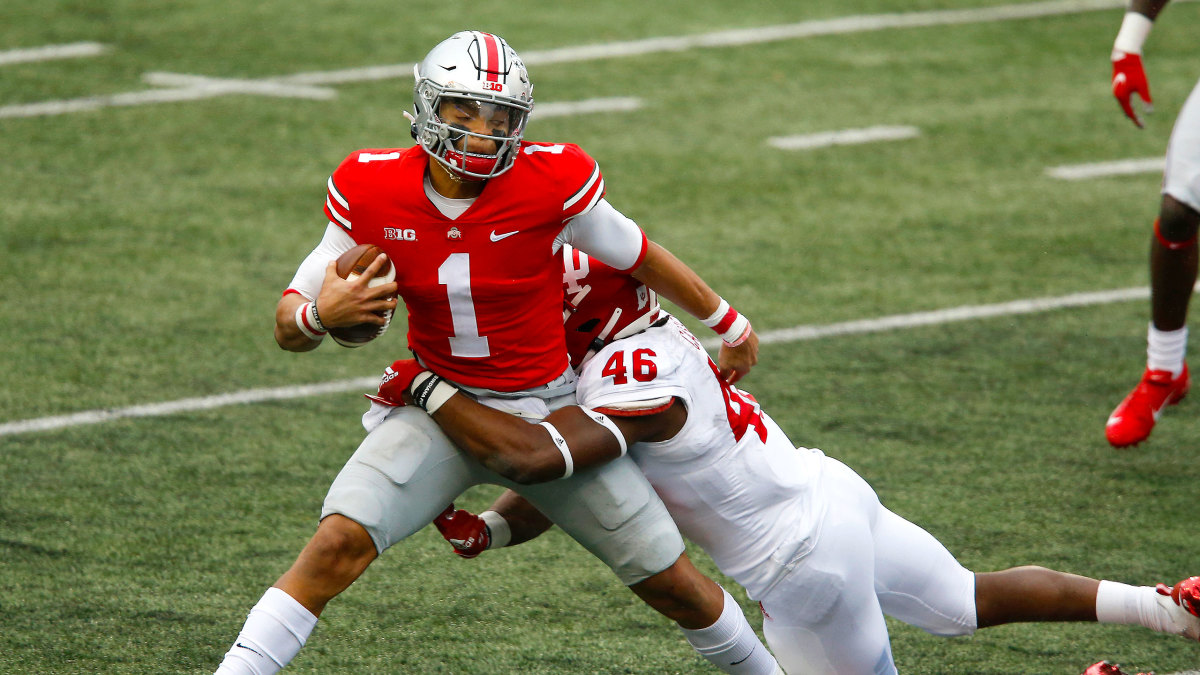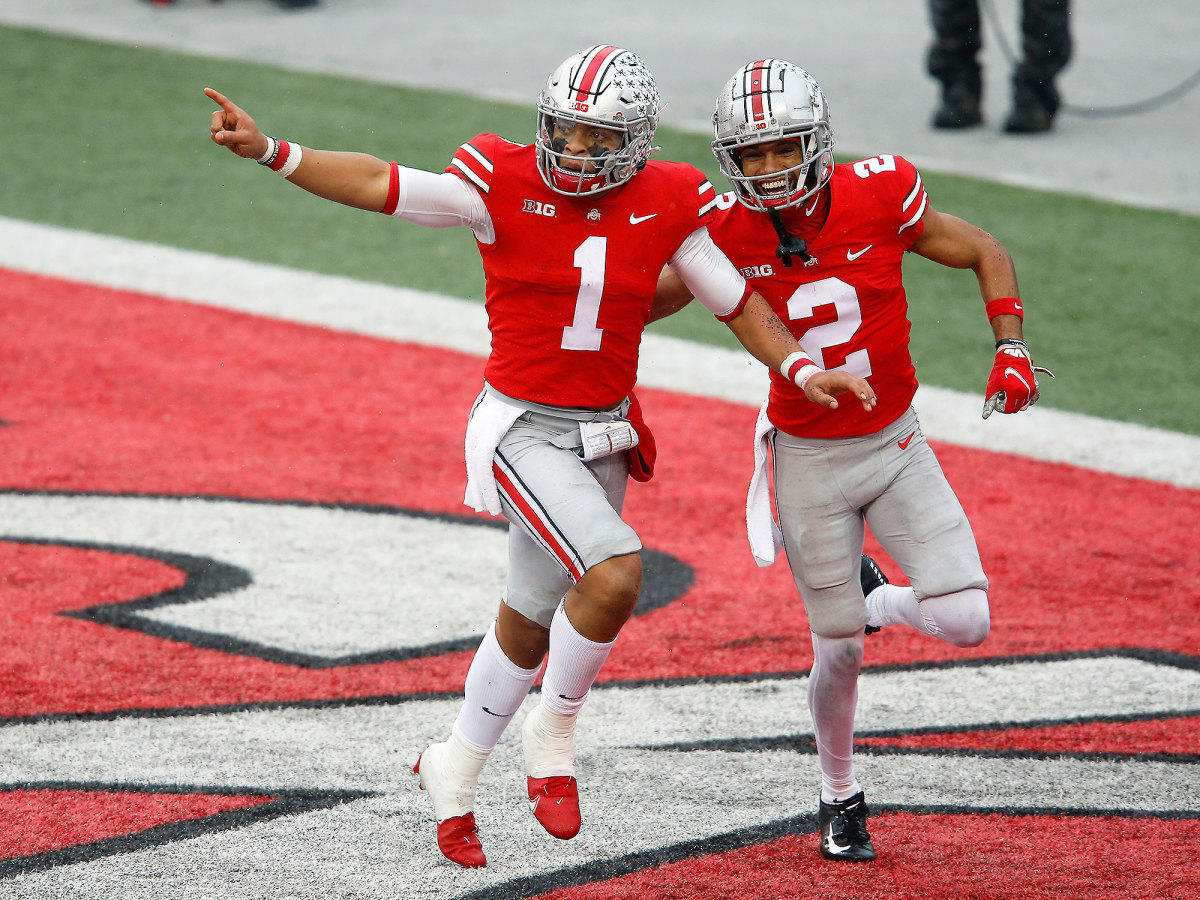With a Second-Half Collapse vs. Indiana, Ohio State Has Allowed Doubt to Creep in
COLUMBUS, Ohio — Early in the third quarter of No. 3 Ohio State’s game Saturday against No. 9 Indiana, I began writing this column. I wrote close to 400 words, in fact.
On the field below me, the Buckeyes were salting away what seemed like another blowout conference victory, up four touchdowns with no real concerns defensively even if there were some offensive hiccups.
I had calculated all of this research to show how wide the gap has gotten between Ohio State and the rest of the Big Ten, how they’ve won 19 straight league games by an average of 25 points, how the Buckeyes have both out-played and out-recruited other league schools in the kind of dominance that will have them somewhat easily cruising to a College Football Playoff spot.
And then everything changed (and in 2020, that should surprise no one). The Buckeyes went from looking like the class of the conference, head and shoulders above what might be the second-best team in the league, to a team with real problems.
In a move that every sports writer dreads, I highlighted those 400 words and deleted them.
Down on the field, things kept getting worse for Ohio State. The Buckeyes eventually survived, needing a last-minute defensive stand to hang on for a 42–35 victory.
But the damage, in a way, was done. The cracks in the armor apparent. The chips in the concrete obvious. The steel bent.

Indiana and coach Tom Allen exposed Ohio State in a way that we’ve seen none of the other Big Four championship contenders (Alabama, Clemson and Notre Dame) exposed. Sure, Bama allowed 48 to Ole Miss, but the result never felt this in doubt. Yes, Clemson lost, but that was without its star QB and at Notre Dame. The Irish struggled against Louisville too, but this one just felt different.
The Buckeyes secondary, full of former four- and-five star prospects, was shredded for 491 passing yards, the most since 1985, and gave up a whopping four completions of at least 50 yards (OSU allowed one—one!—50-yard completion all of last season).
Star quarterback Justin Fields, one of the Heisman Trophy favorites, threw as many interceptions in this game (three) as he had in his entire career to this point, displaying poor judgement, bad decision-making and indecisiveness.
Ohio State’s offensive line, meanwhile, didn’t keep him clean. Against a blitz-heavy IU unit, the line often caved. Fields was pressured on what seemed like every dropback and he was sacked five times.
To top things off, Buckeyes coach Ryan Day made what many might refer to as a blunder late in the fourth quarter. He passed on a chance to turn a seven-point lead into a two-score advantage, eschewing what would have been a 24-yard field goal and instead attempting a fourth-and-one that his team didn’t convert.
Day was rosy about his team’s performance afterward. Fields played gutsy, he said. The O-line was facing a team, he said, that blitzed “literally every snap.” His secondary was “a little inconsistent,” he conceded. His only real criticism was related to yet another second-half collapse.
“We’ve got to figure out a way to close out games,” Day said. “We haven’t been able to finish. I was jacked up. I thought we were going to run away with it.”
Thing is, this could have been worse. Much worse. The Hoosiers made a half-dozen self-destructive miscues that cost them roughly 28 points. They lost a fumble inside the 5-yard line. They dropped a pass on a critical fourth-down attempt in the first half. They threw a pick-six in the third quarter while down 14. And they fumbled the ball on an interception return inside the Ohio State 10-yard line.
What happens if they don’t make one of those mistakes? What happens if they don’t lose those fumbles, convert that fourth down or don’t toss a pick-six?
Saturday felt like a day in which the Big Four playoff contenders turned into, maybe, the Big Three. So certain that Alabama, Clemson, Notre Dame and Ohio State were destined for the College Football Playoff, maybe we shouldn’t be so sure. Forget about the possibility of a Trevor Lawrence-led Clemson beating Notre Dame badly enough in the ACC championship game to knock the Irish out. Maybe we should be asking if an 8–0 Ohio State, in a lackluster Big Ten, will get in.

The Buckeyes could conceivably finish the regular season having won one game (Indiana) over a team with a winning record. In fact, as it currently stands, their opponents’ cumulative record is 10–20, a .333 winning percentage.
But alas, we all know how difficult it would be for the committee to leave out an unbeaten Big Ten champion. After all, who would they put in instead? A 7–0 Oregon? A 9–1 Texas A&M? The Aggies’ current opponents’ winning percentage is just 37%. Oregon could be even lower, and the Ducks, as of 5:30 ET, were struggling against UCLA. How about a potential two-loss SEC championship game loser like Florida? What about a one-loss Oklahoma State?
There’s enough football left to have this debate another week.
Inside of an empty Ohio Stadium in the cold drizzling rain, we witnessed a football powerhouse carved through by a basketball school. It was quite shocking.
Indiana QB Michael Penix Jr., in fact, out-dueled Fields. He completed 27 of 51 passes for five touchdowns and had a chance at the end to throw a sixth to tie it (or win it if IU would have gone for two). The Hoosiers marched to their own 38 as the seconds ticked off the clock before Penix’s final heave fell incomplete, forcing them into a futile lateral attempt. Indiana’s star wideout, Ty Fryfogle, had a whale of a game against a school that touts itself as DBU: seven catches, 218 yards and three scores.
Is this really a championship defense?
“Definitely,” Ohio State cornerback Shaun Wade said. “Just go from the first half that was a championship defense. It’s not just the defense. We have to find a way to put points on the board, find a way to stop missing field goals and find a way to play better defense.”
The Buckeyes missed a field goal, and their offense scored a single TD in the second half on seven drives. Fields conceded to making “bad decisions,” he said. He attributed his first interception to reading coverage wrong. On his second pick, he was attempting to throw away the ball, only he tossed it into traffic. The third interception “sailed” on him, he said.
“We get up on teams,” he said. “We’ve just got to keep our foot on the pedal.”
And in this bizarre season, with so few data points for the selection committee, hammering that pedal is more important than ever. On Saturday, Ohio State, cruising toward an easy win, let off the gas. The Buckeyes opened the door for doubt to creep in and allowed the story here to change: from the widening gap between them and the rest of the Big Ten to the chasm that appears between them and other national title contenders.
